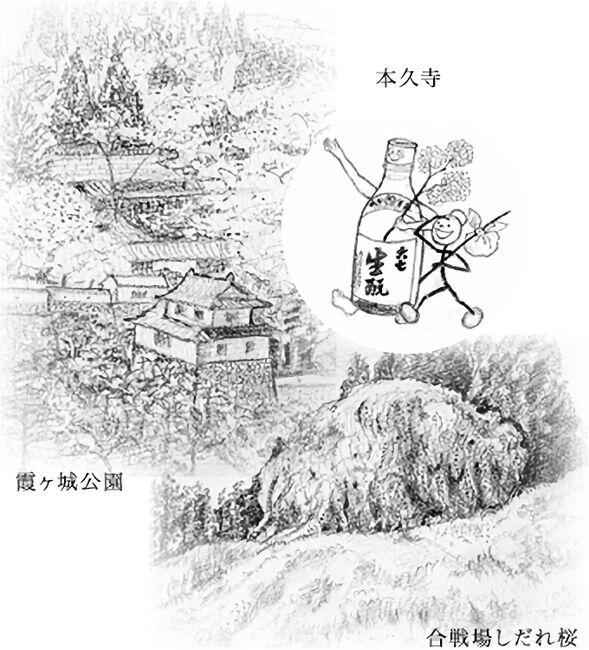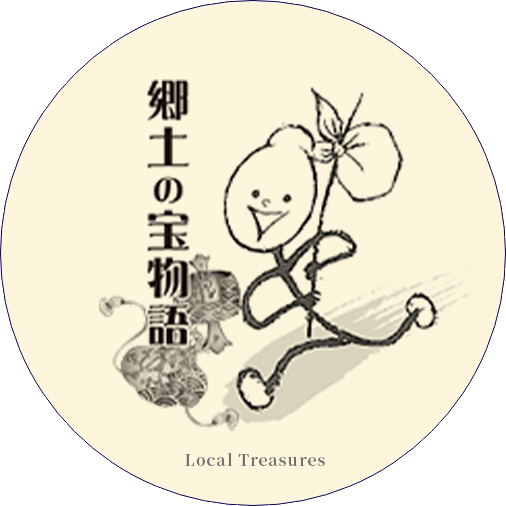| Yeast |
“Spring is at its height, it’s the season of blossom viewing! The Takizakura cherry of Miharu and the Hanamiyama Park of Fukushima are famous blossom spots in our prefecture, but our Nihonmatsu, too, is a treasury of cherry blossoms!” |
| Kimoto |
“Sure! There are huge single trees which are many centuries old, and we also find a whole mountainside covered in Yoshino cherries. I, too, am fond of the cherry blossoms of Nihonmatsu!” |
| Yeast |
“My favorite location is Kasumigajo Castle Park. Around the castle, 2,500 Yoshino cherry trees put out their blossoms like a mist. The local citizens enjoy the park in front of the castle, and they are even more fond of the cherry tree avenue at the back. And from the donjon at the top of the hill there’s a wonderful 360 degree bird’s eye view of 2,500 cherry trees!” |
| Kimoto |
“Hmm, you’re really in the mood! There are also many famous single cherries in Nihonmatsu. For example the ‘Weeping Cherries of the Battle Field,’ a name which goes back to the fact that there is an old battle field here from the Former Nine Year’s War (1051-1063). It looks like one tree, but in fact consists of two over 180 years old weeping cherries. That’s why another name is ‘Husband and Wife Cherry Trees.’” |
| Yeast |
“When the hill is covered like a tapestry in yellow rapeseed flowers, the cherry trees look all the more beautiful.” |
|
 |
| Kimoto |
“Several temples in Nihonmatsu possess large weeping cherry trees with their own stories. On Kannon Hill at the back of Daishichi stand five temples, which all have marvelous old cherry trees. There are also many Yoshino cherry trees on that hill, so when seen in spring from the hill on the opposite side, from Taiunji, the Daishichi Sake Brewery is completely enveloped in cherry blossoms.” |
| Yeast |
“I love that scene too. It is said that the ‘Weeping Cherry of Honkyuji,’ one of the temples on Kannon Hill, was planted in 1643 by Lord Mitsuhide Niwa when he entered the Nihonmatsu domain. That cherry tree really has gracefully shaped branches.” |
| Kimoto |
“There are many other temples in Nihonmatsu which are proud of their cherry trees. The ‘Weeping Cherry of Entoji’ is 400 years old. Its branches are widely spread out, when it is in full blossom it’s a great sight. It has been designated as ‘Green Cultural Property’ of Fukushima Prefecture.” |
| Yeast |
“The ‘Goma Cherry of Aizoji’ is a red early flowering cherry tree, and is shaped like a huge red fountain. The name ‘Goma Cherry Tree’ goes back to the fact that when there was a fire in the temple in the past, a goma stick used in the fire ceremony danced in the sky and came to rest on a branch of this tree.” |
| Kimoto |
“When you come to Nihonmatsu from a northern direction, you pass Michi no Eki Adachi and there stands a cherry tree called ‘Thousand Lantern Cherry.’ In the daytime you can see it against the majestic background of Mt Adatara, and at night it is beautifully lighted up.” |
| Yeast |
“I’d like to add the ‘Giant Cherry Tree of Shionozaki’ from Motomiya, the town next to Nihonmatsu. It is a 600 years old early flowering cherry tree, 18 meters high, and its branches are 20 meters in diameter. It is very elegant and stands on a small hill, surrounded by Yoshino cherries - together this forms a wonderful sight. It’s a natural monument of Fukushima Prefecture.” |
| Kimoto |
“Finally, we shouldn’t forget the ‘Cherry Slope’ of Dake Onsen. Dake Onsen, which lies on the flank of Mt Adatara, has a height difference of 1,500 meters with central Nihonmatsu, so the blossoms come very late. Even when in town at the foot of the mountain the blossoms have already fallen, in Dake Onsen they are just starting. The Sakura Slope reaches from the onsen street all the way to Kagamigaike Park. As the name says, when in full bloom it becomes a cherry blossom tunnel. In the background lies Mt Adatara, still covered by snow.” |
| Yeast |
“Yes! We’re blessed with many beautiful blossom spots. Let’s enjoy some great sake while viewing the cherry blossoms!” |





